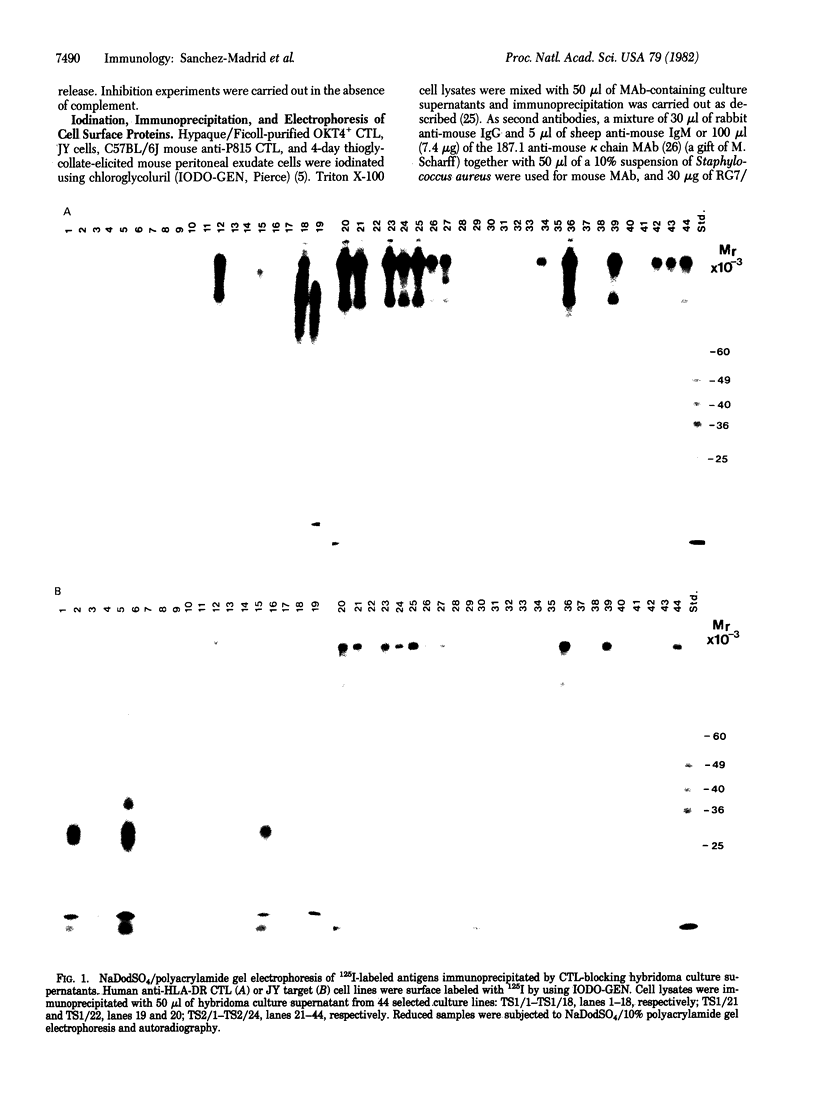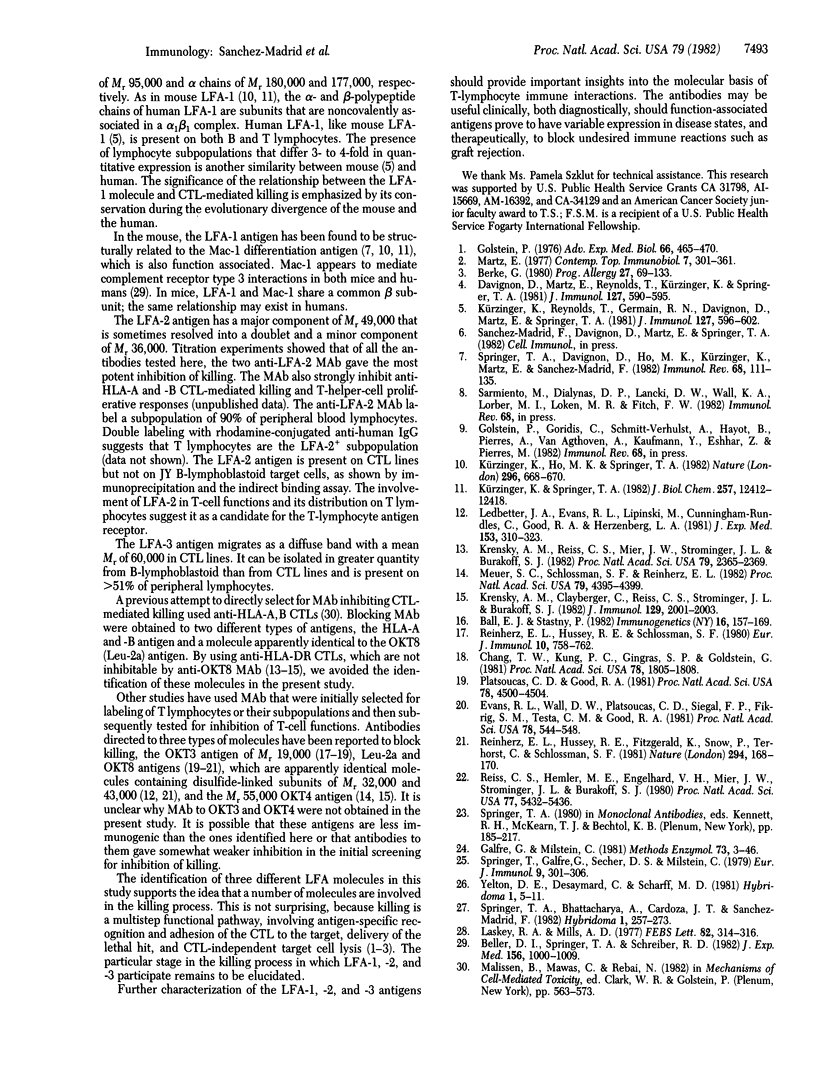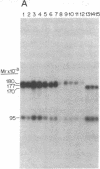Abstract
Monoclonal antibodies were prepared to anti-HLA-DR cytolytic T lymphocytes (CTLs) and screened for inhibition of CTL-mediated killing. Binding of monoclonal antibodies to four types of molecules, LFA-1, LFA-2, LFA-3, and HLA-DR, inhibited killing, suggesting that these molecules participate in the CTL-target cell interaction. The antigens were characterized by immunoprecipitation, crosslinking, NaDodSO4/polyacrylamide gel electrophoresis, and immunofluorescence flow cytometry. The LFA-1 antigen contains alpha and beta polypeptide chains of Mr 177,000 and 95,000 that are noncovalently associated in an alpha 1 beta 1 structure. It is present on both B and T lymphocytes and marks subpopulations that differ in quantitative expression. Human LFA-1 appears to be the homologue of mouse LFA-1. Human LFA-2 is of Mr 49,000 with a minor component of Mr 36,000. It is expressed on CTL lines but not on a B-cell line and in peripheral blood preferentially on T lymphocytes. Human LFA-3 is of Mr 60,000 and is expressed on both B and T lymphocytes.
Full text
PDF




Images in this article
Selected References
These references are in PubMed. This may not be the complete list of references from this article.
- Ball E. J., Stastny P. Cell-mediated cytotoxicity against HLA-D-region products expressed in monocytes and B lymphocytes. IV. Characterization of effector cells using monoclonal antibodies against human T-cell subsets. Immunogenetics. 1982;16(2):157–169. doi: 10.1007/BF00364402. [DOI] [PubMed] [Google Scholar]
- Beller D. I., Springer T. A., Schreiber R. D. Anti-Mac-1 selectively inhibits the mouse and human type three complement receptor. J Exp Med. 1982 Oct 1;156(4):1000–1009. doi: 10.1084/jem.156.4.1000. [DOI] [PMC free article] [PubMed] [Google Scholar]
- Berke G. Interaction of cytotoxic T lymphocytes and target cells. Prog Allergy. 1980;27:69–133. [PubMed] [Google Scholar]
- Chang T. W., Kung P. C., Gingras S. P., Goldstein G. Does OKT3 monoclonal antibody react with an antigen-recognition structure on human T cells? Proc Natl Acad Sci U S A. 1981 Mar;78(3):1805–1808. doi: 10.1073/pnas.78.3.1805. [DOI] [PMC free article] [PubMed] [Google Scholar]
- Davignon D., Martz E., Reynolds T., Kürzinger K., Springer T. A. Monoclonal antibody to a novel lymphocyte function-associated antigen (LFA-1): mechanism of blockade of T lymphocyte-mediated killing and effects on other T and B lymphocyte functions. J Immunol. 1981 Aug;127(2):590–595. [PubMed] [Google Scholar]
- Evans R. L., Wall D. W., Platsoucas C. D., Siegal F. P., Fikrig S. M., Testa C. M., Good R. A. Thymus-dependent membrane antigens in man: inhibition of cell-mediated lympholysis by monoclonal antibodies to TH2 antigen. Proc Natl Acad Sci U S A. 1981 Jan;78(1):544–548. doi: 10.1073/pnas.78.1.544. [DOI] [PMC free article] [PubMed] [Google Scholar]
- Galfrè G., Milstein C. Preparation of monoclonal antibodies: strategies and procedures. Methods Enzymol. 1981;73(Pt B):3–46. doi: 10.1016/0076-6879(81)73054-4. [DOI] [PubMed] [Google Scholar]
- Golstein P. Divalent cation requirements as a tool for the study of cell-mediated cytotoxocity systems. Adv Exp Med Biol. 1976;66:465–470. doi: 10.1007/978-1-4613-4355-4_71. [DOI] [PubMed] [Google Scholar]
- Krensky A. M., Clayberger C., Reiss C. S., Strominger J. L., Burakoff S. J. Specificity of OKT4+ cytotoxic T lymphocyte clones. J Immunol. 1982 Nov;129(5):2001–2003. [PubMed] [Google Scholar]
- Krensky A. M., Reiss C. S., Mier J. W., Strominger J. L., Burakoff S. J. Long-term human cytolytic T-cell lines allospecific for HLA-DR6 antigen are OKT4+. Proc Natl Acad Sci U S A. 1982 Apr;79(7):2365–2369. doi: 10.1073/pnas.79.7.2365. [DOI] [PMC free article] [PubMed] [Google Scholar]
- Kürzinger K., Ho M. K., Springer T. A. Structural homology of a macrophage differentiation antigen and an antigen involved in T-cell-mediated killing. Nature. 1982 Apr 15;296(5858):668–670. doi: 10.1038/296668a0. [DOI] [PubMed] [Google Scholar]
- Kürzinger K., Reynolds T., Germain R. N., Davignon D., Martz E., Springer T. A. A novel lymphocyte function-associated antigen (LFA-1): cellular distribution, quantitative expression, and structure. J Immunol. 1981 Aug;127(2):596–602. [PubMed] [Google Scholar]
- Kürzinger K., Springer T. A. Purification and structural characterization of LFA-1, a lymphocyte function-associated antigen, and Mac-1, a related macrophage differentiation antigen associated with the type three complement receptor. J Biol Chem. 1982 Oct 25;257(20):12412–12418. [PubMed] [Google Scholar]
- Laskey R. A., Mills A. D. Enhanced autoradiographic detection of 32P and 125I using intensifying screens and hypersensitized film. FEBS Lett. 1977 Oct 15;82(2):314–316. doi: 10.1016/0014-5793(77)80609-1. [DOI] [PubMed] [Google Scholar]
- Ledbetter J. A., Evans R. L., Lipinski M., Cunningham-Rundles C., Good R. A., Herzenberg L. A. Evolutionary conservation of surface molecules that distinguish T lymphocyte helper/inducer and cytotoxic/suppressor subpopulations in mouse and man. J Exp Med. 1981 Feb 1;153(2):310–323. doi: 10.1084/jem.153.2.310. [DOI] [PMC free article] [PubMed] [Google Scholar]
- Malissen B., Mawas C., Rebai N. Inhibition of human T cell mediated cytolysis by monoclonal antibodies to effector cell surface structures. Adv Exp Med Biol. 1982;146:563–573. doi: 10.1007/978-1-4684-8959-0_35. [DOI] [PubMed] [Google Scholar]
- Martz E. Mechanism of specific tumor-cell lysis by alloimmune T lymphocytes: resolution and characterization of discrete steps in the cellular interaction. Contemp Top Immunobiol. 1977;7:301–361. doi: 10.1007/978-1-4684-3054-7_9. [DOI] [PubMed] [Google Scholar]
- Meuer S. C., Schlossman S. F., Reinherz E. L. Clonal analysis of human cytotoxic T lymphocytes: T4+ and T8+ effector T cells recognize products of different major histocompatibility complex regions. Proc Natl Acad Sci U S A. 1982 Jul;79(14):4395–4399. doi: 10.1073/pnas.79.14.4395. [DOI] [PMC free article] [PubMed] [Google Scholar]
- Platsoucas C. D., Good R. A. Inhibition of specific cell-mediated cytotoxicity by monoclonal antibodies to human T cell antigens. Proc Natl Acad Sci U S A. 1981 Jul;78(7):4500–4504. doi: 10.1073/pnas.78.7.4500. [DOI] [PMC free article] [PubMed] [Google Scholar]
- Reinherz E. L., Hussey R. E., Fitzgerald K., Snow P., Terhorst C., Schlossman S. F. Antibody directed at a surface structure inhibits cytolytic but not suppressor function of human T lymphocytes. Nature. 1981 Nov 12;294(5837):168–170. doi: 10.1038/294168a0. [DOI] [PubMed] [Google Scholar]
- Reinherz E. L., Hussey R. E., Schlossman S. F. A monoclonal antibody blocking human T cell function. Eur J Immunol. 1980 Oct;10(10):758–762. doi: 10.1002/eji.1830101006. [DOI] [PubMed] [Google Scholar]
- Reiss C. S., Hemler M. E., Englehard V. H., Mier J. W., Strominger J. L., Burakoff S. J. Development and characterization of allospecific long-term human cytolytic T-cell lines. Proc Natl Acad Sci U S A. 1980 Sep;77(9):5432–5436. doi: 10.1073/pnas.77.9.5432. [DOI] [PMC free article] [PubMed] [Google Scholar]
- Springer T. A., Bhattacharya A., Cardoza J. T., Sanchez-Madrid F. Monoclonal antibodies specific for rat IgG1, IgG2a, and IgG2b subclasses, and kappa chain monotypic and allotypic determinants: reagents for use with rat monoclonal antibodies. Hybridoma. 1982;1(3):257–273. doi: 10.1089/hyb.1.1982.1.257. [DOI] [PubMed] [Google Scholar]
- Springer T., Galfré G., Secher D. S., Milstein C. Mac-1: a macrophage differentiation antigen identified by monoclonal antibody. Eur J Immunol. 1979 Apr;9(4):301–306. doi: 10.1002/eji.1830090410. [DOI] [PubMed] [Google Scholar]
- Yelton D. E., Desaymard C., Scharff M. D. Use of monoclonal anti-mouse immunoglobulin to detect mouse antibodies. Hybridoma. 1981;1(1):5–11. doi: 10.1089/hyb.1.1981.1.5. [DOI] [PubMed] [Google Scholar]









